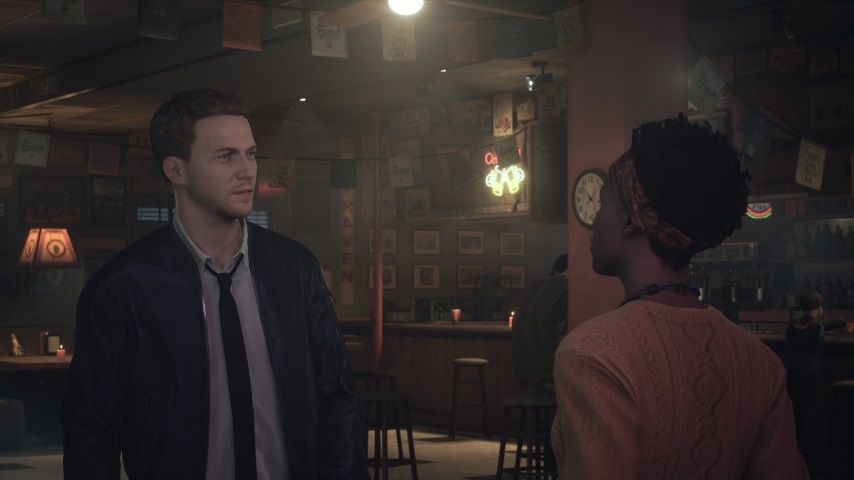
Over the past several games to be released by Dontnod Entertainment, the studio has built itself a reputation. Generally, when you play a Dontnod game, you expect to have a sentimental, thought-provoking experience that deftly melds its dialogue with an innovative narrative device. Life is Strange, Life is Strange 2 and Tell Me Why all tell a deeply personal story of a person of marginalized identity, exploring some of the unique perspectives and formative events that comprise their lives.
This latest from Dontnod, Twin Mirror, is different from its predecessors. It’s more of a mystery detective thriller with puzzle elements than a poignant coming-of-age story. But in straying from key factors of the Dontnod formula, Twin Mirror highlights what works about it and what doesn’t. In the game, former journalist Sam Higgs visits his hometown of Basswood, West Virginia, to attend the funeral of a friend who recently died in a car accident. Almost immediately, he is pushed to investigate the death as a murder, forcing him to confront his past as the muckraker that shut down the town’s only coal mine years ago. Alienated from his former neighbors and friends and still in love with his ex-girlfriend Anna, Sam pursues the case by snooping around town and following leads, deciphering the sequences of critical events with the help of a supernatural headspace known as the Mind Palace. Meanwhile, he is pestered by a man known only as Him, an imaginary figure that weighs in on Sam’s actions as he converses with Anna and potential witnesses. The game culminates in a decision between these two conflicting forces as Sam draws closer to the truth of what happened to Nick, forcing him to choose between his unique powers and a chance to understand and reconnect with the people he loves.

From the game’s opening moments, it’s clear how much of the Dontnod charm lies in its production details. A large portion of their games rely on the player interacting with objects in their environment and listening to the lead character’s observations. That is true of Twin Mirror, but without warm lighting, cute formatting flourishes, and the occasional Sufjan Stevens song, it’s a lot harder to get into the spirit. The game lacks the relaxed atmosphere that would make it pleasant to sit through Sam’s inner thoughts, and we’re introduced to them too early in the game to care about them in the first place. It makes the simple act of reading a trailhead board or snooping through desk drawers horrifically dull, which means much of the game languishes for its tranquility. Who is Sam, and why should we care? The delay of this narrative context hurts our ability to engage with his inner thought life and undermines the other characters. As he reconnects with Anna and his deceased friend’s young daughter, many of the dialogue options feel inconsequential and risk-free, as if he were simply going through the motions. A walk through his friend’s wake takes us on a brief tour of the folksy characters meant to flesh out the town’s whimsy. But Sam’s reticence is alienating, feeling forced and insincere. It’s hard to believe that the events have much impact on Sam at all.
Twin Mirror is also so eager to establish its weirdness that it fails to establish proper pacing. From the way characters or ideas are introduced to investigation sequences that severely need tightening up, each scene lags painfully. Yet for all its unhurriedness, the game impatiently thrusts us into its more abstract concepts with very little warm up. The Mind Palace, where Sam goes to re-experience painful memories or piece together mysteries, has potential. So does the visual manifestation of Sam’s inner thought life, Him. But the clarification on the latter comes too late in the game for us to sympathize with or understand it. The fragments we’re offered are meant to be tantalizing and baiting but lack the narrative padding to be interesting. While the intent may have been to distinguish Twin Mirror, the two concepts wind up competing for attention, diminishing their impact. Neither have context and narrative support to stand on their own feet.
The puzzles of each investigation section, meanwhile, suffer from unclear objectives and lethargic sequencing. Most are very basic, requiring a search for relevant items in a limited space, and there are strange leaps in logic in how they come together. They are not challenging, do not offer any mechanical innovation, and deliver little satisfaction upon completion. They also take much longer than they need to, due to finicky controls.

It may be that Twin Mirror does not offer enough of a gimmick to keep the dialogue interesting. With the original Life is Strange, the time-rewind mechanism was new and subversive in that it was an undoing, rather than doing. It reflected our deep desire to take back certain decisions in our life and try again, facilitating a contemplation of fate and consequence that imbued each dialogue choice with a sense of tension. Twin Mirror, for all its four endings and multiple story branches, doesn’t achieve this. And while the protagonist may be Dontnod’s blandest, there was potential here, with Sam’s emotional maturation throughout the game, to explore the loneliness of poor socialization within traditional masculinity. But the game does not have the resources to explore that depth.
Between the lack of marketing leading up to its release, its poor pacing, and the thin writing and investigation mechanics, Twin Mirror smacks of a game that just wasn’t given enough time. With some polish on the game’s earlier moments and more thoughtful dialogue, it could have stood a real chance. Unfortunately, between the stilted narrative development, cheerless puzzles, and wooden, small-town cliches, there’s less here than whatever remains of Sam’s journalistic career.
Twin Mirror was developed and published by Dontnod Entertainment. Our review is based on the PC version. It is also available for PlayStation 4 and Xbox One.
Holly Green is the editor-at-large of Paste Games and a reporter and semiprofessional photographer. She is also the author of Fry Scores: An Unofficial Guide To Video Game Grub. You can find her work at Gamasutra, Polygon, Unwinnable, and other videogame news publications.